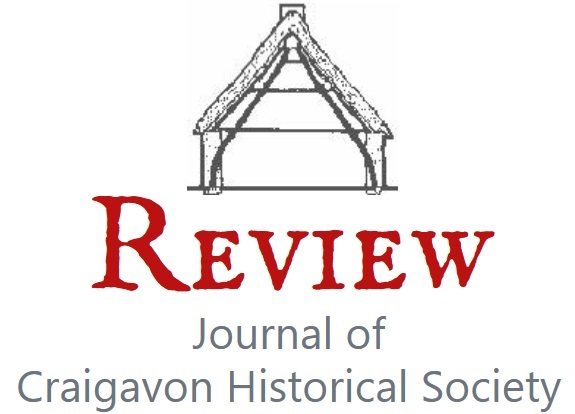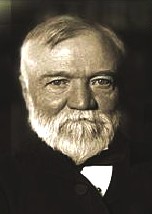
1996/97 - 1997
The opening of the Carnegie Library
by Kieran Clendinning

"the richest man in the world"
January 8th, 1906, under the most auspicious circumstances and in the presence of a select gathering of the principal residents of Lurgan and its vicinity, the new Carnegie Free Library and Reading Rooms was formerly opened by Mrs. McGeagh, wife of Mr. H. G. McGeagh, the chairman of Lurgan Urban Council and chairman of the Free Library Committee.
Ten years previous to the opening of the new premises in Carnegie Street, Lurgan was the second provincial town - Dundalk being the first - in Ireland to take advantage of the Free Libraries Act by placing one penny on the rates and opened a library and reading room in the basement of the Town Hall. This institution, from its inception, proved to be an unqualified success and, due to a number of people availing themselves of the facilities on offer, the small floor space in the basement became so overcrowded and overtaxed that it was felt that a new accommodation was needed.
Majority support a free library
The idea of a free library was first discussed by the Town Commissioners in 1889, and after considerable delay a motion was carried in 1891, adopting the provisions of the Free Library Act of 1854. This was followed by a plebiscite of the voters of the township, who then numbered 650, with the result that the adoption of the Act was carried by a large majority.
The person who was largely responsible for the promotion of a free library for the town was Mr. William White, the editor and proprietor of the "Lurgan Times" while the chief mover in the council was Mr. John McCaughey, who was ably backed by Mr. William Livingston. The chairman of the council at that time, Mr. Malcolmson, also gave the movement every assistance and support.
Middle Row demolished
From 1891 to 1894 nothing was done by the council further than to strike a halfpenny on the rate, the proceeds of which were allowed to accumulate. During the intervening period many efforts were made to get the library housed in Lord Lurgan's office - the old Middle Row - which had been purchased In 1893 by the Town Commissioners. However, as it was the considered opinion of the town fathers that this building was a 'blot' on the main street, the building was purchased with the object of improving the main street and was demolished in 1894.
Mentioning Lord Lurgan's agent's house and office in the Middle Row, it is remarkable how tastes in architectural styles change. By to-day's standards the building would certainly not have been a blot, if one was to consider the ugly design of the public toilets [since demolished] which are anything but an ornament to a town centre of such proportions as Lurgan. Lord Lurgan's office building was not strictly part of the Middle Row but was in fact a Georgian House which was also the residence of the agents such as William Handcock and Claud Brownlow. Unfortunately, this building was allowed to fall into disrepair, when the agent's residence was moved to the 'Head of the Long Plain', with the building of the red brick Manor House.
First free library opens
When the first Free Library first saw the light of day or rather the partial light of day-in the basement of the Town Hall, adjoining the clerk's office - the best that could be procured at that time - the opening ceremony was performed by Mr. McCaughey, chairman of the new library committee. In 1898, the library accommodation was enlarged by the commissioners handing over to the library committee the clerk's office and transferring the clerk's office to the upstairs room in the Town Hall.
The rooms were then in anything but good condition for a library; the bare walls and tiled floors were made habitable and furniture and books purchased out of the accumulated rates of three years.
Carnegie Trust gives financial support
From this time forward the rates were raised by 1d [old penny] in the £, the limit of rating at the time the library was brought into a practicable scheme. In 1902 a Mr. Hazleton, chairman of the council who took a great interest in the matter, applied to the Carnegie Trust for a donation towards building a library and an immediate reply was received from them, that the trust would be pleased to provide a fund of £2,000 towards the building of a Free Library in Lurgan.
The Carnegie Trust was founded in 1896 by Andrew Carnegie the Scottish born American millionaire steel magnate, who is particularly remembered for the public libraries he endowed.
In 1904, Mr. McGeagh visited America and met Dr. Andrew Carnegie in his New York residence, and shortly after this Mr. McGeagh, on his return to Lurgan, urged the council lo adopt a plan to appoint Mr. Henry Hobart, a Dromore architect, to draw up plans. These plans having met with approval, tenders were sought and the successful contractor was C. Callaghan of Magheralin. The sub-contractors were: Heating and Plumbing, John Long & Sons, Lighting, David Douglas; Plastering, David McGibbon; Furnishings, William Burns.
The architectural description of the building according to the official programme, dated Monday, January 1906, is as follows:-
"The building, which is erected on a plot of ground in Carnegie Street, having 90 feet of frontage with a depth of 48 feet from front to rear, is designed as a free treatment of modified Gothic. All principal fronts are faced with the best Seagoe perforated brick and inside walls throughout are built of Belfast stock brick. Red Aspatria sandstone, supplied by Macormick, Antrim Road, Belfast, has been used for the arch over the principal entrance and for copings, label strings and window sills.
"The arch over the principal entrance, which springs off columns of red stone with carved caps and moulded bases has the words "Free Library'" cut in the face of same in bold letters of suitable character. This archway, through which one enters the vestibule, is protected by a Botwick's collapsible steel gate. The hall is approached from the vestibule by wide swinging doors, the upper panes of which are plate glass to allow supervision, also leading to the reading rooms 40 feet by 25 feet on the right hand side of the hall and the recreation and smoke room 27 feet by 25 feet on the left hand side. Off the hall is placed a lavatory and sanitary arrangements of the most approved type for general use, and off the stairs landing a cloakroom and lavatory for ladies is provided. A fine easy staircase in three flights leads from the hall to the first floor, and is lighted by a large cathedral glass window of superior design bearing the town's coat of arms.
"On the first floor is placed the book lending department, suitable counter and fittings provided. The library is entered off [the] landing by a wide door and is a fine well lighted room 40 feet by 25 feet. Here shelves and bookcases are provided for many hundreds of volumes. The floor of the vestibule is laid with encaustic tiles, while the walls around the apartments have a dado finished in Keen's cement with bold mouldings at the top, all joints of the windows being similarly finished and moulded. The staircase and ceilings are in selected pitch pine with moulded mahogany rails; all interior woodwork is yellow pine painted green satin and varnished.
Modern heating and ventilation
The ventilation of the building has been carried out with the latest improved system, the inlet and exhaust ventilators being supplied by Donald & Donald. Glasgow. The building throughout is heated on a low pressure system by a boiler of the "Ideal" make and radiators - 12 in number - are placed throughout the various rooms. The Reading Room as already stated, 24ft by 40ft, contains 15,000 cubic feet of airspace; the Recreation Room 25ft by 29ft, 11,280, cubic feet, the Library, 40ft by 24ft., 16,860 cubic feet; and the Hall and Lobby, 9,802 cubic feet."
Opening ceremony
The opening ceremony took place at 3 o'clock that January Monday afternoon in the presence of a 'select assemblage'. On the proposition of Dr. James Moore, vice-chairman of the Urban Council, the ceremony was gracefully performed by Mrs. McGeagh who, in commemoration of the occasion, was presented by Dr. Moore with an exceedingly handsome gold key bearing in enamel the Lurgan coat of Arms with the motto "Be Just and Fear Not" and underneath the following inscription, 'To Mrs. McGeagh on the occasion of her opening the Carnegie Free Library, 8th January, 1906 - H. G. McGeagh, chairman of the council; F. W. Pollock, town clerk; Francis Sloan, hon. sec., F.L. Committee.' The key was designed by D. Neill, Belfast. After the opening ceremony had been performed the company proceeded to the reading room for the reception.
Some of those who attended
Among those who attended were the Very Rev. Dr. O'Loughlin, Dean of Dromore; the Very Rev. James O' Hare, P.P., Rev. W. B. Sprole; Rev. Henry Ball; Rev. W. H. Weir; Dr. Samuel Agnew; Dr. James Moore, Dr. Braken; Dr. Deeney; Dr. Martha Adams; Mr. James Malcolm, D. L.; Major Greer; Mr. H. G. McGeagh: Mr. Stewart; Mr. John Caughey, Belfast; John Clendinning, J.P.; Mr. John McNally. J.P.; Mr. James Cowan, Mr. Owen Mahoney D.I.; Mr. James Johnston; Mr. C. Johnston, solicitor; Mr. W. J. Fleming, solicitor; Mr. W. C. Neill, town solicitor; Mr. D. Malcolmson, solicitor; Robert Pedlow; Mr. Wm. Bigley, J.P. Portadown; Mr. Henry Hobart, Architect; Mr. Anthony Bunting; Mr. J. S. Dennison; Mr. Fred Pollock; Mr. W. J. Lark; Mrs. Wm. Greer, the Wilderness; Mrs. George Greer and Miss Greer, Woodville; Mrs. James Malcolm and Miss Malcolm; Miss Fforde, Mile House; Mrs. H. G. McGeagh; Mrs. James Johnston and Misses Johnston; Miss Claredon; Miss Beatty; Miss Jane Johnston; Mrs. W. J. Allen; the Misses Ross; Miss Darling; Mrs. John Clendinning; Mr. James Greer; Mr. Wm. White; Mr. Richardson; Mr. Joseph Harrison: Mr. Wm. Livingston, Annesborough; Mr. Wm. Sloan; Mr. H. Shillington; Mr. John Mehaffey; Mr. Thomas Clarke, Springfield; Mr. Tallentire; Mr. Hugh Ross; Mr. P. Doyle: Mr. Davis Johnston; Mr. Fred Magahan; Mr. ColIins; Mr. Watson, Lakeview; Mr. James Clendinning; Albert Malcolmson; Mr. Richard Soye; Hugh O'Hanlon, Union Street; Mr. McClatchie; Mr. Magurran; Andrew Halliday; Edward Lunn; Mr. W. J. Pollock; Mr. Jousua McNeeice; Mr. M. Hazley; Mr. D. Drennan; Mr. Wm. Millar; Mr. Wm. lrwin; Mr. J. Newell; Mr. George Livingston; Mr. Joseph Herbert; Mr. David Pedlow; Mr. Henry Ball; Mr. John McConville; Mr. B. Cullenan; Mr. R. G. Lonsdale; Mr. Wm. Shields; Mr. Thomas Ramsey; Mr. Frank McCann; Mr. Andrew Cherry; Mr. James Englis; Mr. N. G. Leeper and Mr. A. Malcolmson.